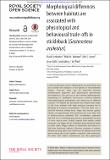Morphological differences between habitats are associated with physiological and behavioural trade-offs in stickleback (Gasterosteus aculeatus)
Date
29/06/2016Metadata
Show full item recordAbstract
Local specialization can be advantageous for individuals and may increase the resilience of the species to environmental change. However, there may be trade-offs between morphological responses and physiological performance and behaviour. Our aim was to test whether habitat-specific morphology of stickleback (Gasterosteus aculeatus) interacts with physiological performance and behaviour at different salinities. We rejected the hypothesis that deeper body shape of fish from habitats with high predation pressure led to decreases in locomotor performance. However, there was a trade-off between deeper body shape and muscle quality. Muscle of deeper-bodied fish produced less force than that of shallow-bodied saltmarsh fish. Nonetheless, saltmarsh fish had lower swimming performance, presumably because of lower muscle mass overall coupled with smaller caudal peduncles and larger heads. Saltmarsh fish performed better in saline water (20 ppt) relative to freshwater and relative to fish from freshwater habitats. However, exposure to salinity affected shoaling behaviour of fish from all habitats and shoals moved faster and closer together compared with freshwater. We show that habitat modification can alter phenotypes of native species, but local morphological specialization is associated with trade-offs that may reduce its benefits.
Citation
Seebacher , F , Webster , M M , James , R S , Tallis , J & Ward , A J W 2016 , ' Morphological differences between habitats are associated with physiological and behavioural trade-offs in stickleback ( Gasterosteus aculeatus ) ' , Royal Society Open Science , vol. 3 , 1603316 . https://doi.org/10.1098/rsos.160316
Publication
Royal Society Open Science
Status
Peer reviewed
ISSN
2054-5703Type
Journal article
Description
F.S. and A.J.W.W. were supported by the Australian Research Council, M.M.W. was supported by The University of St Andrews and R.S.J. and J.T. were supported by Coventry UniversityCollections
Items in the St Andrews Research Repository are protected by copyright, with all rights reserved, unless otherwise indicated.

